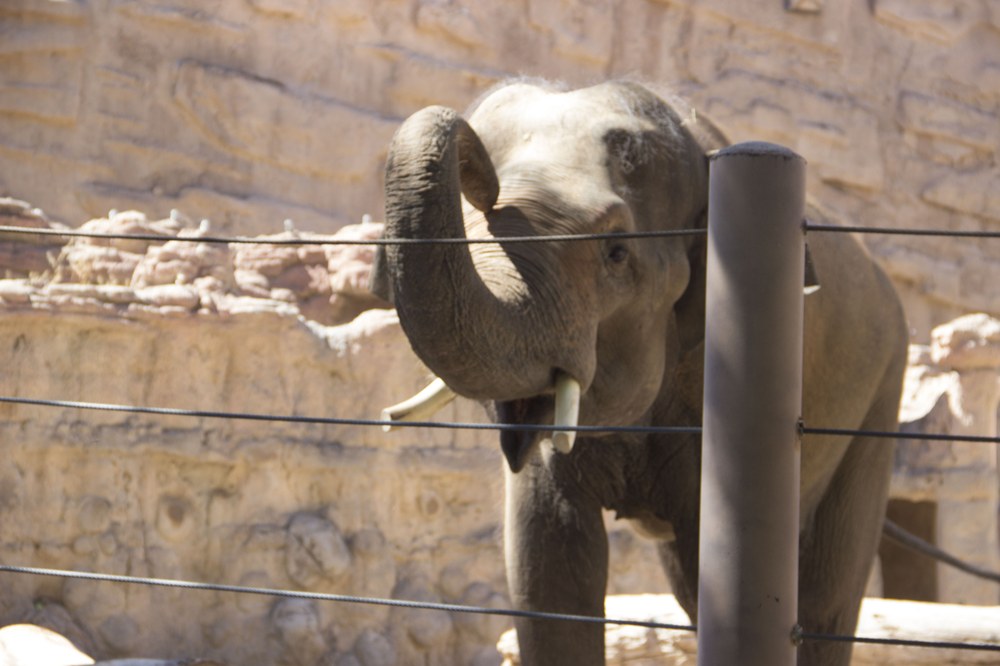Training Zoo Animals
ABQ BioPark zookeepers are also expert trainers who use their bonds to improve animal healthcare.
Popular Training Requests
Station: The animal is asked to come to the keeper.
Shift: The animal is asked to move from one location to another.
Scale: The animal is asked to get on a scale.
Open: The animal is asked to open its mouth.
Present: An animal is asked to present a specific body part for examination.
11/01/2017 - It may be daunting to think about convincing a gorilla or a jaguar to willingly participate in medical procedures, but ABQ BioPark zookeepers have it down to a science.
Jack the gorilla can present his fingers through his door to receive a nail clipping. Giraffes voluntarily enter a chute system that helps keepers obtain their weight. And animals zoo-wide are participating in similar tasks.
But they didn’t get there overnight. Through patience, consistency and bond building, zookeepers shape animals’ natural behaviors through a process called operant conditioning (or training). The overall goal is to capture natural behaviors to create a proactive healthcare program for each animal, said Erin Flynn, ABQ BioPark curator of mammals.
Here’s how it works—an animal offers a behavior that it normally would, such as a hippo opening its mouth wide for a big yawn. Zookeepers work closely with the animal to shape this into a behavior that would be beneficial for proactive health care like checking teeth and gums. Trainers use both hand and verbal cues. When the animal offers the desired behavior, zookeepers mark it with a whistle blow, a click from a clicker training device or a vocal affirmation like “good boy.”
“There is a natural language barrier when you work with animals until you learn how to communicate with each other,” said Flynn. “It is a powerful and bonding experience for both animals and keepers when they are able to figure out how to understand each other.”
Trainers reinforce desired behaviors with a reward or “jackpot.” For many animals, this means treats like apple bits or hay, but it could also be anything the animal prefers. Flynn said jaguars, rhinos and elephants all enjoy receiving hose play. Other animals might enjoy receiving a new form of enrichment or moving into a preferred bedroom.
Zookeepers never pressure animals to offer a behavior. If they are uninterested during a training session, staff will disengage and try again later.
“Trust is absolutely critical to working with animals, and we feel strongly about giving the animals opportunities to make choices,” said Flynn. “It takes that trust to ask an animal to come over to its keeper at a barrier, tell it that it is going to get a vaccination, and have it stand still to receive the vaccination at the barrier, followed quickly by a high value treat. The animal has the option to leave at any time, or not to come over to begin with. The animals in our care choose to participate because of the relationship they have developed with the keepers and the positive techniques we use to train them.”

Samson, a male Asian elephant, raising his trunk for inspection. Photo: ABQ BioPark.
At first, each animal has a primary trainer. Learned behaviors can be transferred to another trainer later, but care must be taken to replicate the primary trainer’s technique. Even small differences like a misplaced hand can hinder an animal’s progress. That's why the zoo sometimes records training sessions to later view for inconsistencies among trainers.
“Ultimately, our goal is to provide each keeper the ability to work with an animal and ask for the same behaviors in the same way," said Flynn.
Both animal and staff safety is of utmost importance, so the majority of training is done with some sort of a barrier between animal and trainer—this could be a gate or a bedroom door. Favorite diet items may also be given with some precaution. For example, zookeepers use tongs to feed the jaguars to create an extension of their hand.
A few trainers are able to work one on one with an animal without protective barriers. Flynn noted, however, this type of training is only done after careful safety consideration from zoo supervisors. Zookeepers never enter an enclosure alone with an animal.
“Teaching the animals to voluntarily participate in their care is an important part of life in modern zoos and aquariums, said Flynn. “It improves the welfare of the animals in our care by dramatically increasing the scope of the routine care of that we are able to offer the animals in a minimally invasive and least stressful way. This way things like brushing teeth, administering vaccinations, trimming claws, inspecting scrapes and bumps, and applying medicine become no big deal.”
Story: Tina Deines
The ABQ BioPark has several Amazon wish lists that contain some training products like target sticks, training whistles, treat training pouch bags, training clickers and more. You can make a purchase to benefit the ABQ BioPark’s operant conditioning programs.

